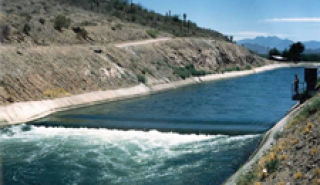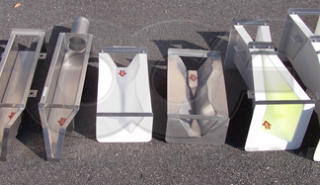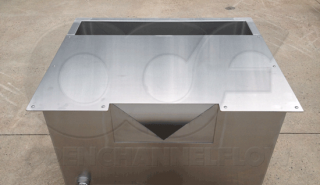Many kinds of flume are in use today around the world, in applications as diverse as dam seepage monitoring to industrial pre-treatent discharge. These flumes can be divided into two different classes: short throated and long throated.
Short throated flumes are considered to be short in that flow is controlled in a specific region of the flume to produce curvilinear results. In use, short throated flumes may in fact be relatively long, depending upon flume style and size. The Cutthroat, HS / H / HL, and Parshall are all examples of short throated flumes, with the Parshall flume being the most common style - accounting for more than half of annual installations in North America.
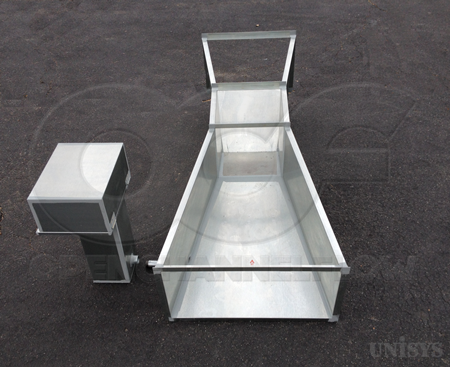
Long throated flumes control flow with a throat that is long enough to cause parallel (nearly) flow lines in the section of flow control. The development of parallel flow allows long throated flumes to be rated through the use of fluid flow concepts alone (versus short throated flumes which are rated though emperical methods). Ramp (modified broad crested weirs) and RBC (Replogle, Bos, Clemens) are styles of long throated flumes.
Point of Meaurement
Emperically rated, short throated flumes have a single, defined point of measurement. Measuring upstream of this point will overestimate the flow, measuring downstream will underestimate the flow.
For long throated flumes, any point upstream of the throat draw down is sufficient - so unlike short throated flumes, there is measurement flexibility.
Equations
The equations used for long throated flumes are generally not supported in meters by the industry leaders in permanent and portable flow metering. This, then, requires that raw level data be transfered either in batch downloads or through SCADA systems to a device capable of applying a longer form equation (PLC, Field Controller, or computer). For some organizations, this additional complexity isn't considered a barrier as the flow data is already collected and manipulated at a central location. For other users, though,
Additionally, as long throated flumes are not standardized in their dimensions - in that they are developed specifically for each site - operators going from site to site must pay special attention in making sure they are applying the right flow equations. This may sound like a no-brainier, but this is something we see time and time again. We also see this when new personnel are hired or where equipment has failed and no one has written down the flow information.
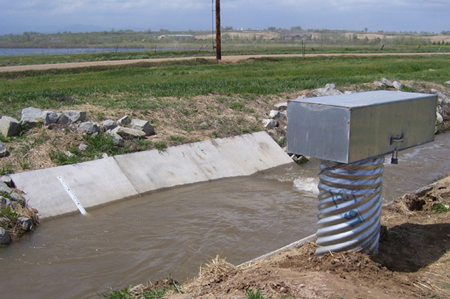
Standardized Sizes
The flip side to the lack of standardization for long throated flumes is that long throated flumes can be tailored to the flow / channel configurations of each specific site. Instead of trying to apply a flume style or size that doesn't quite match the site requirements, long throated flumes allow a level of customization unmatched by short throated flumes. Long throated flumes can be developed with nearly any cross-sectional shape desired and fitted to most canal geometries.
Short throated flumes, on the otherhand, have layouts and dimensions specifc to each class of flume. For the Parshall flume (and its modified Montana form) there are 22 sizes. While these sizes cover many potential applications, there are situations where the standard sizes are not suitable. For most styles of short throated flumes interpolation between sizes is not appropriate. The exception to this limitation is the Cutthroat flume, where intermediate throat widths can be developed for standard lengths.
However, for many municipal and industrial applicatons, operators are only monitoring flow equipment as part of a wide range of maintenance or environmental tasks at a facility. Here the familiarity of the short throated flumes and their standardized sizes is a distinct advantage.
Accuracy & Submergence
Long throated flumes can be computer calibrated to within +/- 2% (plus the usual head measurement error). Short throated flumes tend to be accurate to within +/-3-5% (with Palmer-Bowlus flumes tending towards +/- 4-6%).
While indicaton accuracy is important, of greater relevance to end users can be the higher resistance of long throated flumes to submergence. Submergence is the effect of downstream water level on flow through a flume. Submergence transition (the ratio of upstream water level at the primary point of measurement, Ha, to the downstream water level, Hb) is the point at which downstream water levels retard flow through a flume to the point where it is no longer considered to be free-flowing. Submergence transitons for long throated flumes are up to 90%, while short throated flumes can range from 0% (Montana flumes) to 90% - depending upon flume style and size. Most short throated flumes exhibit submergence transitions from 50-80%.
Image: Deer & Ault Consultants
Source: Water Measurement Manual, Chapter 8 - Flumes, Section 8 Long-Throated Measurement Flumes


